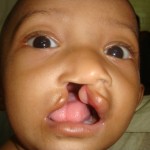
About 75% of cleft lip and palate patients have a bony defect in the gum of the mouth (alveolar cleft). If not repaired it gives rise to many problems. While bone grafting is widely accepted by professionals in cleft care, there is still controversy around the technique, timing, site from which bone is taken and whether artificial bone substitutes offer any benefits.
This Cochrane review found two small studies, one comparing a graft using a new material with a traditional graft, the other looking at the benefit of applying a special type of glue to the graft. Both studies were considered to be of poor quality and so no conclusions could be reached about whether either of these new techniques is better than the traditional type of graft.
Secondary alveolar bone graft is thought to have a number of benefits:
- Providing support for teeth proximal to the cleft enhances follow-up orthodontic treatment
- Gives a bony base for eruption of teeth in the line of the cleft
- Provides union to the maxillary arch and re-establishes alveolar bone contour
- Supports to arch width and minimizes collapse of the maxillary arch
- Stabilizes the maxillary segments for the maintenance of the dentition and mastication
- Reduces notching of the alveolar ridge
- Eliminates oronasal fistulae so improving oral hygiene
- May improve facial appearance
But may cause:
- Increased incidence of canine impaction
- Donor site morbidity
- Reduced anterior-posterior and/or vertical maxillary growth
Although secondary alveolar bone grafting has been widely accepted by professionals within cleft care, there is still controversy as to:
- The age at which is should be carried out
- The type of graft and the site from which the donor bone will be harvested
- Whether orthodontic treatment prior to grafting influences outcome
In the UK the Clinical Standards Advisory Group (CSAG) reported that only 58% of children had a successful graft. This review set out to compare the effectiveness and safety of different secondary bone grafting methods (timing, source of graft and technique).
They found 582 potential studies of which two met the inclusion criteria. One trial compared alveolar bone grafting using artificial materials (InFuse bone graft substitute impregnated with BMP-2) with a traditional iliac graft. The other trial investigated the application of fibrin glue to the bone graft. Both trials were small with 21 and 27 patients and were assessed as being at high risk of bias. Any apparent differences between the interventions for outcomes in either study must therefore be treated with great caution and are not highlighted here.
The authors concluded:-
Due to the high level of risk of bias in the two included trials there is insufficient evidence to conclude that one intervention is superior to another.
Guo J, Li C, Zhang Q, Wu G, Deacon SA, Chen J, Hu H, Zou S, Ye Q. Secondary bone grafting for alveolar cleft in children with cleft lip or cleft lip and palate. Cochrane Database of Systematic Reviews 2011, Issue 6. Art. No.: CD008050. DOI:10.1002/14651858.CD008050.pub2.
